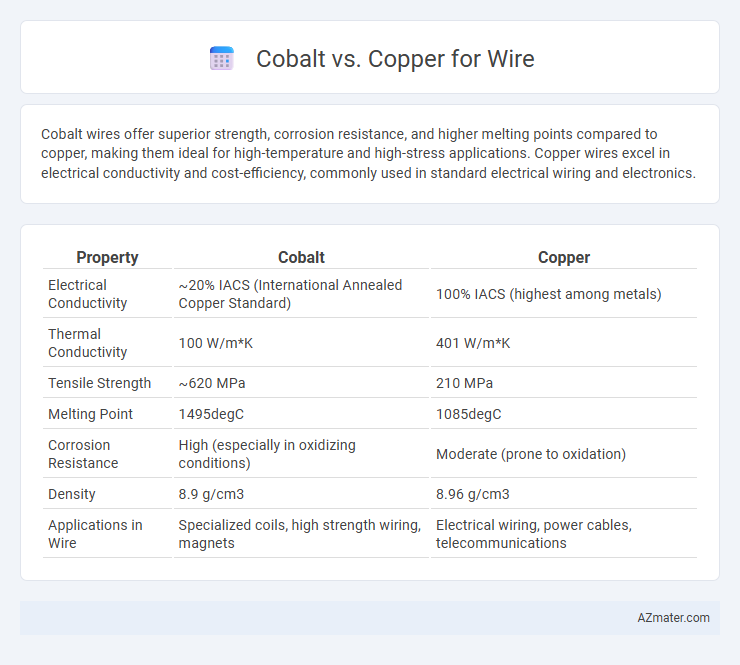Cobalt wires offer superior strength, corrosion resistance, and higher melting points compared to copper, making them ideal for high-temperature and high-stress applications. Copper wires excel in electrical conductivity and cost-efficiency, commonly used in standard electrical wiring and electronics.
Table of Comparison
| Property | Cobalt | Copper |
|---|---|---|
| Electrical Conductivity | ~20% IACS (International Annealed Copper Standard) | 100% IACS (highest among metals) |
| Thermal Conductivity | 100 W/m*K | 401 W/m*K |
| Tensile Strength | ~620 MPa | 210 MPa |
| Melting Point | 1495degC | 1085degC |
| Corrosion Resistance | High (especially in oxidizing conditions) | Moderate (prone to oxidation) |
| Density | 8.9 g/cm3 | 8.96 g/cm3 |
| Applications in Wire | Specialized coils, high strength wiring, magnets | Electrical wiring, power cables, telecommunications |
Introduction to Cobalt and Copper as Wire Materials
Cobalt and copper are both important materials used in wire manufacturing, with copper being the most widely utilized due to its excellent electrical conductivity and ductility. Cobalt, though less common, offers superior strength and corrosion resistance, making it valuable in specialized wire applications requiring durability and performance under extreme conditions. Copper wires are preferred in electrical and telecommunications industries, while cobalt wires find niche uses in aerospace, medical devices, and high-temperature environments.
Electrical Conductivity: Cobalt vs Copper
Copper offers superior electrical conductivity at approximately 5.96 x 10^7 S/m, making it the preferred choice for wiring due to efficient current flow and minimal energy loss. Cobalt, with a significantly lower electrical conductivity around 1.7 x 10^6 S/m, is less efficient for electrical transmission but valued in specialized applications requiring greater strength and corrosion resistance. The conductivity difference highlights copper's dominance in electrical wiring, while cobalt serves niche roles where mechanical properties outweigh electrical efficiency.
Thermal Properties and Heat Resistance
Cobalt wire demonstrates superior thermal stability compared to copper, maintaining consistent conductivity at elevated temperatures up to 1,495degC, whereas copper softens around 1,085degC, limiting its heat resistance. The higher melting point of cobalt enhances durability in high-temperature environments, making it ideal for applications like aerospace and electronic components exposed to intense heat. Copper, favored for its excellent electrical conductivity, excels in standard wiring but underperforms in thermal resilience relative to cobalt.
Mechanical Strength and Durability
Cobalt wires exhibit superior mechanical strength compared to copper, making them more resistant to deformation under stress and ideal for high-stress environments. Copper, while highly conductive, has lower tensile strength and is more prone to fatigue and fatigue-related failures over time. The enhanced durability of cobalt wire is attributed to its higher hardness and corrosion resistance, which contribute to longer service life in demanding electrical and mechanical applications.
Corrosion Resistance and Longevity
Cobalt offers superior corrosion resistance compared to copper, making it ideal for harsh environments where oxidation and degradation are concerns. Its enhanced durability contributes to greater longevity in electrical wiring applications, reducing maintenance and replacement frequency. Copper remains widely used for its excellent electrical conductivity, but cobalt's resistance to corrosion extends the lifespan of wires significantly in demanding conditions.
Cost Comparison of Cobalt and Copper Wires
Copper wires are widely preferred due to their lower cost, with prices averaging around $4 to $6 per pound, making them more economical for large-scale electrical applications. Cobalt wires, on the other hand, are significantly more expensive, typically costing upwards of $30 per pound because of cobalt's rarity and high demand in specialized industries. This substantial price difference drives most manufacturers to favor copper for wiring, reserving cobalt wire for niche applications requiring superior magnetic or corrosion-resistant properties.
Availability and Sourcing Challenges
Cobalt faces significant sourcing challenges due to its concentration in politically unstable regions like the Democratic Republic of Congo, leading to supply chain volatility and higher costs compared to copper. Copper benefits from more abundant and geographically diversified deposits worldwide, ensuring consistent availability and more stable market pricing. The scarcity and ethical concerns surrounding cobalt mining limit its large-scale adoption in wiring applications relative to copper's well-established supply infrastructure.
Applications in Industry and Electronics
Cobalt wire offers superior magnetic properties and high-temperature resistance, making it ideal for specialized electronics such as magnetic sensors and high-performance connectors. Copper wire remains the industry standard due to its excellent electrical conductivity, affordability, and ease of fabrication, widely used in power transmission, telecommunications, and circuit boards. In industrial applications, cobalt's durability suits harsh environments, while copper's versatility supports general electrical wiring and electromagnetic devices.
Environmental Impact and Sustainability
Cobalt mining poses significant environmental challenges due to habitat destruction and toxic waste, while copper extraction also involves substantial energy use and water pollution but benefits from more established recycling programs. Copper's higher recyclability and widespread reuse reduce its environmental footprint compared to cobalt, which remains limited in recycling infrastructure. Sustainable wire production increasingly favors copper for its balance of conductivity and lower ecological impact, although innovations in cobalt recycling could improve its sustainability profile.
Choosing the Right Material: Key Considerations
Cobalt and copper differ significantly in electrical conductivity and corrosion resistance, making copper the preferred choice for most wiring applications due to its superior conductivity of 58 MS/m compared to cobalt's approximately 17 MS/m. Copper's excellent ductility and cost-effectiveness support efficient current flow and ease of installation, while cobalt's higher strength and resistance to oxidation are beneficial in specialized environments requiring durability and heat resistance. When choosing between cobalt and copper wire, key considerations include the specific electrical conductivity needs, mechanical strength requirements, environmental exposure, and overall project budget.

Infographic: Cobalt vs Copper for Wire
 azmater.com
azmater.com